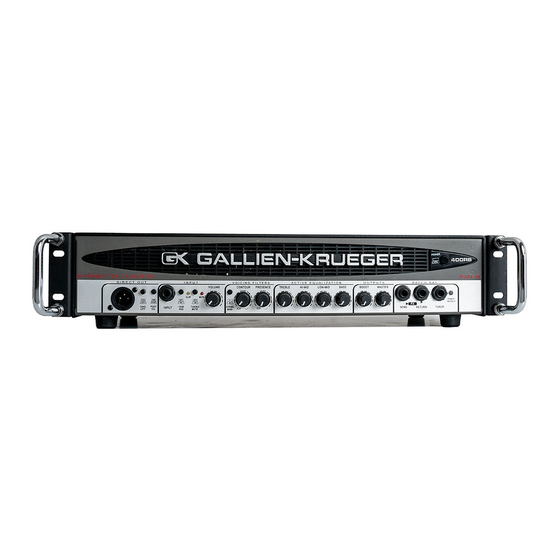Gallien-Krueger 400RB series Operating Instructions - Page 2
Browse online or download pdf Operating Instructions for Amplifier Gallien-Krueger 400RB series. Gallien-Krueger 400RB series 4 pages. High-current bass amplifier
Also for Gallien-Krueger 400RB series: Owner's Manual (16 pages)

Operating Instructions
400RB
THE BASICS
Your new 400RB represents the latest advances that technol-
ogy has to offer. It was designed to provide the widest possible
range of usable sounds. The combination of three voicing filters
with four bands of active EQ is unbeatable for flexibility and
ease of operation. This amplifier has many features, all of which
are described here. A careful examination of this manual will
help you to get the most from them.
INPUT SECTION
This section contains the 1/4'' input jack and the input attenuator.
With the attenuator out the maximum input level is 1Vrms (3V
P-P). For larger input signals the input attenuator should be set.
This reduces the gain of the input stage by 10 dB, increasing the
input head room to 3V rms (10 P-P).
EFFECTS LOOP
Located on the rear panel, it is provided for the insertion of
effects. It is post EQ but pre boost and master. Using standard
guitar cords connect the effects input to the send and the effects
output to the return. The boost and master controls will effect
any signal put into the return jack. The level is 1.5V rms (4.5V
P-P) into 100K ohm.
DIRECT OUT
This output will put 500mv into 600 ohms unbalanced. It can be
used with a direct box or can be connected directly to the high
"Z" input of a mixer.
SPEAKERS
Two Speaker jacks are provided on the rear panel and will accept
a total load of 4 ohms. Lower impedances should not be used.
This unit can drive one four ohm speaker or two eight ohm
speakers, maximum. Higher impedances such as eight or sixteen
ohms are acceptable. No damage will result from operating the
amplifier with the speaker disconnected.
POWER SWITCH
The power switch and associated pilot light are located in the
lower right hand corner of the front panel.
FUSE
Located on the rear panel, never operate this amplifier with any
other than the recommended fuse.
120V operation - replace with type 3AG4A
240V operation - replace with type 3AG2A
MAINTENANCE
Your new amplifier is rugged. It was built to give you a lifetime
of trouble-free operation if it is operated in accordance with the
instructions above. The only maintenance required is cleaning.
We recommend a soft damp cloth and mild soap for cleaning the
outside surfaces. If you are going to pack your amplifier around
a lot, we recommend a road case to protect it from scratches and
road wear.
Setting up your Sound
Your amplifier is designed to sound about right with the tone
controls set flat (5). We therefore recommend you start with the
EQ set flat and the voicing filters out.
Helpful Hints
1. Don't be afraid to experiment with the EQ on your bass first.
Make sure that you have as close to the sound you want
from your bass before adjusting the EQ on your amp.
2. Set your playing level first. You may want to push up your
volume and boost levels while dropping back the master.
This will give a fatter sound but can add distortion. Some
players find this desirable, you will have to be the judge.
For the cleanest possible sound, operate the master on 10
(max). The boost control is footswitchable and can act as a
pre-set volume. The L.E.D. next to the boost control
indicated that boost is on.
3. Once your basic levels are set, work with the voicing filters.
The Lo Cut is a bass roll off and is used to control stage
rumble at high volume. Mid Cut puts a notch at about
500hz giving a mellow round sound. Hi Boost adds edge
and definition.
4. Having set your levels and filters, you are ready to fine tune
your tone. This is an involved procedure requiring you to
use your ears to tell you what is right. We have broken the
sound spectrum into four basic bands and provided active
controls for each. Adjustment procedures are repetitive and
require patience.
TREBLE : Boost and cut at 4khz, will add or remove
edge and definition.
HIGH MID : Boost and cut at 1khz. There is a lot of
sound in this band, it works on the lower
harmonics of your instrument and affects the
punch of your sound.
LOW MID : Boost and cut at 250hz. Basically this
band affects the body of your sound.
BASS : Boost and cut at 60hz. Affects only the bottom
end and will be used to account for varying
room accoustics.
